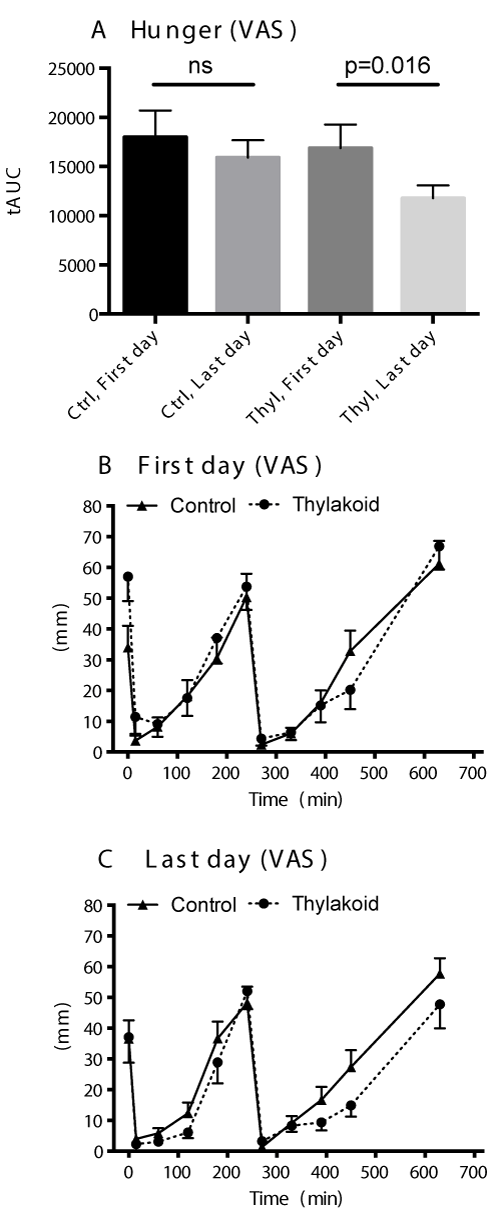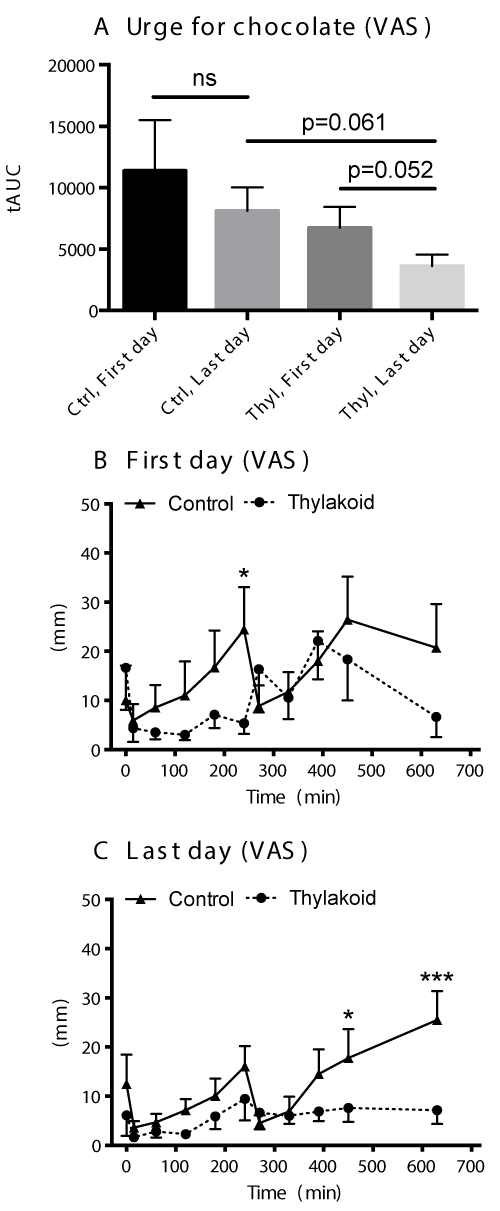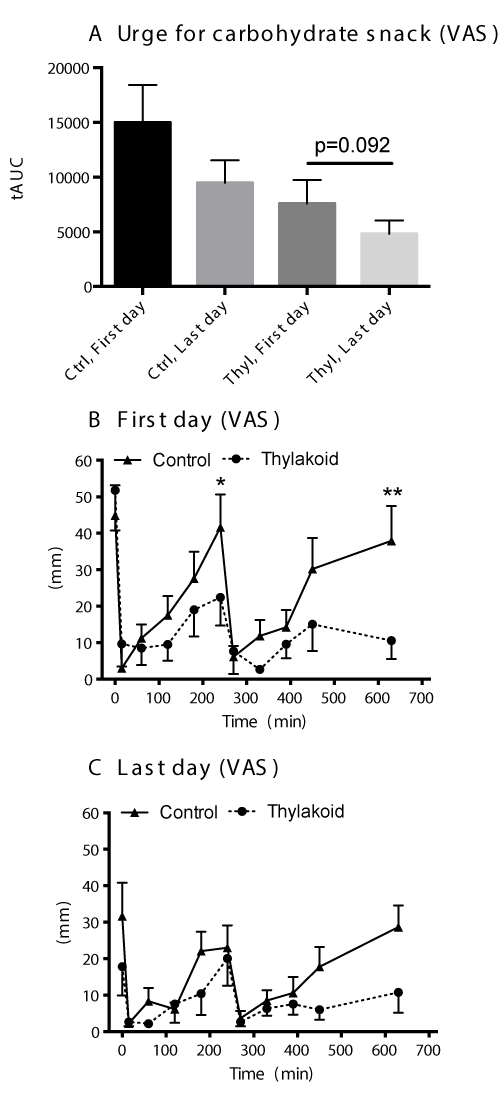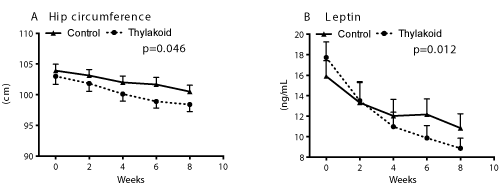Research Article Open Access
Decreased Urge for Palatable Food after a Two-month Dietary Intervention with Green-plant Membranes in Overweight Women
| Eva-Lena Stenblom1, Caroline Montelius1, Daniel Erlandsson1, Line Skarping1, Maria Fransson1, Emil Egecioglu1, Krzysztof Podgórski2 and Charlotte Erlanson-Albertsson1* | |
| 1Department of Experimental Medical Science, Appetite Regulation Unit, Faculty of Medicine, Lund University, Sölvegatan 19, 221 84 Lund, Sweden | |
| 2Department of Statistics, School of Economics and Management, Lund University, Tycho Brahes väg 1, 220 07 Lund, Sweden | |
| Corresponding Author : | Charlotte Erlanson-Albertsson Department of Experimental Medical Science Appetite Regulation Unit, Lund University Sölvegatan 19, 221 84 Lund, Sweden Tel: +46 46 222 85 89 Fax: +46 46 222 40 22 E-mail: charlotte.erlanson-albertsson@med.lu.se |
| Received November 12, 2014; Accepted November 28, 2014; Published November 29, 2014 | |
| Citation: Stenblom EL, Montelius C, Erlandsson D, Skarping L, Fransson M, et al. (2014) Decreased Urge for Palatable Food after a Two-month Dietary Intervention with Green-plant Membranes in Overweight Women. J Obes Weight Loss Ther 4:238. doi:10.4172/2165-7904.1000238 | |
| Copyright: © 2014 Stenblom EL, et al. This is an open-access article distributed under the terms of the Creative Commons Attribution License, which permits unrestricted use, distribution, and reproduction in any medium, provided the original author and source are credited. | |
Visit for more related articles at Journal of Obesity & Weight Loss Therapy
Abstract
Background/Aim: The present study investigates the effect of daily green-plant membrane (thylakoid) supplementation for two months on body weight, body composition, metabolic profile and rating of appetite sensations in overweight women on a restricted diet. Methods: 26 women, Body Mass Index (BMI) 27.5 ± 1.9, randomized into a thylakoid (n=12) and control group (n=14), followed a 7500 kJ/day diet with or without 5.6 g of thylakoids supplemented in a blueberry drink, and exercised 60 minutes per day. Fasting blood samples were taken with two weeks interval. On the first and last day of the study subjects answered Visual Analogue Scale (VAS) questions regarding hunger and cravings. Results: Both control and thylakoid-treated groups lost body weight and body fat over the course of the study, but no differences were found between the groups. Thylakoid supplementation resulted in decreased hunger (p=0.016) and decreased urge for chocolate (p=0.052) in contrast to the control group. Leptin levels were significantly reduced at the end of the study in the thylakoid-treated group (p=0.012) compared to control, suggesting a decreased fat mass. The overall metabolic profile was also improved in the treated group compared to controls, based on body weight, waist and hip-circumference, trunk and total body fat, p-leptin, p-LDL, p-ApoB1, ptotal cholesterol, p-TAG, blood glucose, p-HbA1C and p-insulin (p=0.024). Conclusions: Thylakoids added to food in adjunct to lifestyle intervention may be helpful in enabling overweight subjects to lose weight by suppression of hedonic hunger.
Methods: 26 women, Body Mass Index (BMI) 27.5 ± 1.9, randomized into a thylakoid (n=12) and control group (n=14), followed a 7500 kJ/day diet with or without 5.6 g of thylakoids supplemented in a blueberry drink, and exercised 60 minutes per day. Fasting blood samples were taken with two weeks interval. On the first and last day of the study subjects answered Visual Analogue Scale (VAS) questions regarding hunger and cravings.
Results: Both control and thylakoid-treated groups lost body weight and body fat over the course of the study, but no differences were found between the groups. Thylakoid supplementation resulted in decreased hunger (p=0.016) and decreased urge for chocolate (p=0.052) in contrast to the control group. Leptin levels were significantly reduced at the end of the study in the thylakoid-treated group (p=0.012) compared to control, suggesting a decreased fat mass. The overall metabolic profile was also improved in the treated group compared to controls, based on body weight, waist and hip-circumference, trunk and total body fat, p-leptin, p-LDL, p-ApoB1, p-total cholesterol, p-TAG, blood glucose, p-HbA1C and p-insulin (p=0.024).
Conclusions: Thylakoids added to food in adjunct to lifestyle intervention may be helpful in enabling overweight subjects to lose weight by suppression of hedonic hunger.
One reason for overeating is the inability of palatable food to promote appetite control [4]. Appetite control occurs through the release of various gut hormones [5] including the hunger hormone ghrelin, and the satiety promoting hormones Cholecystokinin (CCK) and Glucagon-like Peptide 1 (GLP-1) [6].
Previously, we have shown that green-plant membranes, thylakoids, have a hunger suppressing, as well as a satiety promoting, effect. In one single-meal study, general hunger was decreased three hours following intake of thylakoids with breakfast [7]. A sustained suppression of hedonic hunger for the whole day has also been shown following intake of thylakoids with breakfast [8]. Suppression of general and hedonic hunger was related to the release of the satiety hormones CCK [7] and GLP-1 [8]. Furthermore, suppression of ghrelin levels in humans has previously also been demonstrated following intake of thylakoids [9]. Thus thylakoids affect hunger and the release of three hormones important for appetite control; ghrelin, CCK and GLP-1.
In a previous study, thylakoids were shown to decrease body weight in human following daily treatment for three months [8]. These effects were achieved without any caloric restriction. However, most weight loss programs are based on a caloric restriction. Hence, we were interested to find out whether treatment with thylakoids would augment body weight loss during a caloric restriction commonly used in weight loss studies [10].
In this study, a daily supplementation of thylakoids for two months in overweight women was used, together with a caloric restriction of 15 Energy % (E%). In addition to following body weight and metabolic parameters we also studied subjective ratings of hunger, satiety and cravings for palatable food.
Procedures, objectives and requirements of the study were explained in detail to the participants, and written consents were signed both before screening and before the study started. The study was approved by the Ethical Committee of Lund University, and conducted in accordance with the declaration of Helsinki. After completing the study, all participants received a compensation of 2000 Swedish Crowns (SEK) (taxable).
Every second week, at the same time in the morning, the participants visited the clinic for measurements of body weight, body composition, waist- and hip circumferences and for blood sampling. To optimise conditions for all measurements, the participants were instructed to have a standardised dinner in the evening before each test day and to abstain from further intake of foods or liquid after 8.00 pm.
The participants had a total of five individually scheduled appointments during the study. On the first and the last day (day 1 and 56), following the anthropometric measurements and blood sampling, an isocaloric breakfast (2114 kJ/505 kcal) consisting of the blueberry drink with or without thylakoids, yoghurt with apple, breakfast cereal, nuts and coffee or tea was served (Table 2). After 240 minutes an isocaloric take-away lunch (2593 kJ/630 kcal) consisting of a frozen thai-curry meal, bean salad and a banana was administered. VAS questionnaires measuring subjective parameters of hunger, satiety and urge for specific foods were filled out at given time points throughout the day on both day 1 and 56.
The thylakoid group received 5.6 g of thylakoid powder mixed with 2.8 g rapeseed oil (Zeta, Di Luca & Di Luca AB, Stockholm, Sweden) and 50 g of blueberry soup (Ekströms original, Procordia Food AB, Eslöv, Sweden). The control group received 2.8 g rapeseed oil mixed with 50 g blueberry soup. The blueberry drinks with and without thylakoids contained 209 kJ/50 kcal versus 188 kJ/45 kcal respectively. The drinks were taken before breakfast every day.
Subjects were also instructed to accomplish 60 minutes of low/medium intensity exercise each day, such as power walking, swimming, basic aerobics etc.
Each day, the participants answered questions regarding their choice of meals, health-status and exercise in a diary. These data were used to analyse the compliance with the study guidelines.
Statistical analyses of the VAS questionnaires were done using Prism, version 6 (GraphPad Software, Inc, San Diego, CA, USA). On the first and last days respectively, the variations in ratings during the day were analysed with a two-way repeated measures ANOVA with treatment and time as fixed factors. Individual time points were further analysed with a multiple comparison test followed by Fisher´s LSD test. Numerical calculations of Total Area under the Curve (tAUC) were analysed with Wilcoxon matched-pairs signed ranks test to compare the difference between first and last days of the study within the groups. The Mann-Whitney t-test was also used to compare differences between the groups.
Objective data exhibited normal distribution for most variables and some deviations from normal assumption for certain variables (HbA1c, Apo B and body weight in the thylakoid group), but not critical for the result of the analysis. The latter was assessed by a resampling study. In the figures, data are expressed as mean ± SEM, while in the tables data are given as mean ± SD. P-values <0.05 were considered to be statistically significant, and p-values <0.1 to be of interest.
Analysis of subjective ratings of hunger, using VAS questionnaires, revealed a decreased sensation of hunger within the thylakoid group at the end of the study compared to the first day (p=0.016, Figure 1A), whereas no change of hunger sensation was found in the control group (Figure 1A). No differences in hunger sensations were found between the thylakoid group and control on the first day (F(10,240)=1.6, ns) or on the last day of the study (F(10,210)=0.83, ns) (Figure 1B and 1C).
A strong tendency for a reduction in the urge for chocolate within the thylakoid group was observed at the end of the study compared to the first day (p=0.052) but not in the control group (p=0.62, Figure 2A). The ANOVA analysis of the urge for chocolate between treated and control on the first day and the last day respectively revealed a significant interaction between time and treatment first day; (F(10,240)=1.9, p<0.05), last day (F(10,230)=1.9, p<0.05). Analysis of individual time points showed a decreased urge for chocolate in the treatment group prior to lunch on the first day and in the afternoon on the last day (Figure 2B and 2C).
The urge for a carbohydrate snack was not significantly altered over the course of the study in any of the groups (Figure 3A). There was however an interaction between time and treatment in the urge for a carbohydrate snack on the first day of treatment (F(10,240)=2.1, p<0.05), but not on the last day (F10,230)=1.3, ns, Figure 3C). The urge for a carbohydrate snack was decreased prior to lunch and in the afternoon on the first day (Figure 3B).
Regarding metabolic parameters, there was a significant difference between the control and treatment groups, when comparing the whole series of weekly changes, using Hotelling´s two-sample T2-test (Table 4, p=0.024, T2=3.28). When analysed individually, a significant difference between control and treatment groups was found in p-leptin (p=0.012) (Figure 4B) and hip circumference (p=0.046) (Figure 4A).
There were no differences in baseline values between thylakoid and control groups. No side effects of the thylakoid supplementation were reported.
Even though the body weight reduction was similar between the two groups, it would appear that this level of weight loss was reached with less effort in the thylakoid-treated group compared to the control group, based on the reduced subjective ratings of hunger and urge for palatable food in the thylakoid group. This suggests that thylakoids exert their appetite controlling effect even during caloric restriction and that this effect is sustained following weight loss. This is an important property of thylakoid treatment, since hunger is common upon weight loss and often leads to overeating and body weight regain [13].
In the present study, the overweight women treated with thylakoids had a larger decline of p-leptin compared to control, indicating that loss of fat tissue was increased by thylakoid treatment. Low leptin values following body weight and body fat reduction is a natural consequence, which often leads to hunger and overeating, since leptin is a postprandial satiety signal. Low leptin levels are said to constitute an important drive for eating; thus explaining the rapid weight gain that often follows a weight loss program [13]. However, thylakoids appear to have the ability to counteract the drive for hunger associated with low leptin levels.
In addition to the effects of thylakoids on single parameters (Table 4), there was an overall improved metabolic profile in the thylakoid-treated group, based on measures of body weight, trunk and total body fat, waist and hip circumference, p-leptin, p-LDL-cholesterol, p-Apo B1, p-total cholesterol, p-TAG, b-glucose, p-insulin and p-HbA1c, compared to control. Further studies are needed to substantiate these effects, in specific patient cohorts with diabetes and/or dyslipidaemia.
A reduction in the urge for palatable food following thylakoid treatment has been observed earlier, in a study where overweight women were treated for three months with a daily supplement of thylakoids [8]. In contrast to the present study, there was no caloric restriction in the weight loss programme during the 12 weeks of intervention, only a recommendation to eat no more than three meals per day. With such a regimen, the thylakoid-treated women lost significantly more weight than controls (0.41 kg/week in the thylakoid group and 0.29 kg/week in the control group). Hence, thylakoids are more efficient for weight loss in the absence of any caloric restriction. In the 12-week study, there was also a reduced urge for palatable food in the thylakoid treated group that was sustained throughout the treatment period [8]. Thus thylakoids appear to be able to suppress hunger, in particular hedonic hunger, irrespective of caloric restriction.
Previous studies have demonstrated that thylakoids inhibit fat digestion transiently due to a reversible inhibition of lipase/colipase in the intestine [11,14,15]. Through this effect the whole gastrointestinal processing of food is extended. This is likely the explanation for the suppression of ghrelin levels following thylakoid consumption [9,16]. The prolonged gastro-intestinal food digestion also explains the increased release of CCK [7,9] and GLP-1 by thylakoids [8]. Other effects are a prolonged uptake of glucose [16-18] and an improved intestinal microflora [18]. The differences between the thylakoid and the control groups found in the present study may be related to one or several of these effects of thylakoids in the intestine.
The reduced feelings of hunger could thus be due to the suppression of ghrelin and/or an increased release of CCK or GLP-1 by thylakoids. Likewise, the observed suppression of urge for chocolate could be an effect of the above gut hormones. Most importantly, the suppressed hunger and urge for palatable food remained throughout the diet intervention, even following body weight loss.
In conclusion, the present study, even though limited by a short time-period of intervention and a relatively small number of participants, demonstrates that a caloric restriction conceals the effect of thylakoids on body weight loss. However, the effects on homeostatic and hedonic hunger remain. We suggest that thylakoid treatment may alleviate some of the strains coupled to caloric restriction during body weight loss programs.
References
- Lowe MR, Butryn ML (2007) Hedonic hunger: a new dimension of appetite? Physiol Behav 91: 432-439.
- Flegal KM, Carroll MD, Kit BK, Ogden CL (2012) Prevalence of obesity and trends in the distribution of body mass index among US adults, 1999-2010. JAMA 307: 491-497.
- Mozaffarian D, Hao T, Rimm EB, Willett WC, Hu FB (2011) Changes in diet and lifestyle and long-term weight gain in women and men. N Engl J Med 364: 2392-2404.
- Erlanson-Albertsson C (2005) How palatable food disrupts appetite regulation. Basic Clin Pharmacol Toxicol 97: 61-73.
- Ashwood P, Anthony A, Pellicer AA, Torrente F, Walker-Smith JA, et al. (2003) Intestinal lymphocyte populations in children with regressive autism: evidence for extensive mucosal immunopathology. J Clin Immunol 23: 504-517.
- Woods SC (2006) Dietary synergies in appetite control: distal gastrointestinal tract. Obesity (Silver Spring) 14 Suppl 4: 171S-178S.
- Stenblom EL, Montelius C, Östbring K, Håkansson M, Nilsson S, et al. (2013) Supplementation by thylakoids to a high carbohydrate meal decreases feelings of hunger, elevates CCK levels and prevents postprandial hypoglycaemia in overweight women. Appetite 68: 118-123.
- Montelius C, Erlandsson D, Vitija E, Stenblom EL, Egecioglu E, et al. (2014) Body weight loss, reduced urge for palatable food and increased release of GLP-1 through daily supplementation with green-plant membranes for three months in overweight women. Appetite 81: 295-304.
- Köhnke R, Lindbo A, Larsson T, Lindqvist A, Rayner M, et al. (2009) Thylakoids promote release of the satiety hormone cholecystokinin while reducing insulin in healthy humans. Scand J Gastroenterol 44: 712-719.
- Astrup A, Rössner S, Van Gaal L, Rissanen A, Niskanen L, et al. (2009) Effects of liraglutide in the treatment of obesity: a randomised, double-blind, placebo-controlled study. Lancet 374: 1606-1616.
- Emek SC, Szilagyi A, Akerlund HE, Albertsson PA, Köhnke R, et al. (2010) A large scale method for preparation of plant thylakoids for use in body weight regulation. Prep Biochem Biotechnol 40: 13-27.
- Flint A, Raben A, Blundell JE, Astrup A (2000) Reproducibility, power and validity of visual analogue scales in assessment of appetite sensations in single test meal studies. Int J Obes Relat Metab Disord 24: 38-48.
- Blundell JE, Gillett A (2001) Control of food intake in the obese. Obes Res 9 Suppl 4: 263S-270S.
- Albertsson PA, Köhnke R, Emek SC, Mei J, Rehfeld JF, et al. (2007) Chloroplast membranes retard fat digestion and induce satiety: effect of biological membranes on pancreatic lipase/co-lipase. Biochem J 401: 727-733.
- Köhnke R, Svensson L, Valverde Piedra JL, Pierzynowski S, Weström B, et al. (2010) Feeding appetite suppressing thylakoids to pigs alters pancreatic lipase/colipase secretion. Livestock Science 134: 68-71.
- Montelius C, Szwiec K, Kardas M, Lozinska L, Erlanson-Albertsson C, et al. (2014) Dietary thylakoids suppress blood glucose and modulate appetite-regulating hormones in pigs exposed to oral glucose tolerance test. Clin Nutr 33: 1122-1126.
- Montelius C, Gustafsson K, Weström B, Albertsson PÅ, Emek SC, et al. (2011) Chloroplast thylakoids reduce glucose uptake and decrease intestinal macromolecular permeability. Br J Nutr 106: 836-844.
- Montelius C, Osman N, Weström B, Ahrné S, Molin G, et al. (2013) Feeding spinach thylakoids to rats modulates the gut microbiota, decreases food intake and affects the insulin response. J Nutr Sci 2: e20.
Tables and Figures at a glance
| Table 1 | Table 2 | Table 3 | Table 4 |
Figures at a glance
 |
 |
 |
 |
| Figure 1 | Figure 2 | Figure 3 | Figure 4 |
Relevant Topics
- Android Obesity
- Anti Obesity Medication
- Bariatric Surgery
- Best Ways to Lose Weight
- Body Mass Index (BMI)
- Child Obesity Statistics
- Comorbidities of Obesity
- Diabetes and Obesity
- Diabetic Diet
- Diet
- Etiology of Obesity
- Exogenous Obesity
- Fat Burning Foods
- Gastric By-pass Surgery
- Genetics of Obesity
- Global Obesity Statistics
- Gynoid Obesity
- Junk Food and Childhood Obesity
- Obesity
- Obesity and Cancer
- Obesity and Nutrition
- Obesity and Sleep Apnea
- Obesity Complications
- Obesity in Pregnancy
- Obesity in United States
- Visceral Obesity
- Weight Loss
- Weight Loss Clinics
- Weight Loss Supplements
- Weight Management Programs
Recommended Journals
Article Tools
Article Usage
- Total views: 15077
- [From(publication date):
December-2014 - Jul 04, 2025] - Breakdown by view type
- HTML page views : 10442
- PDF downloads : 4635
